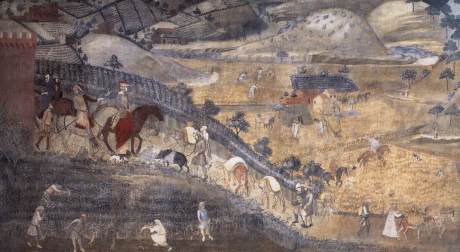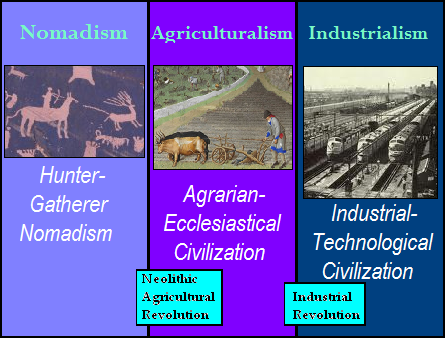The Agrarian-Ecclesiastical Thesis
18 June 2013
Tuesday
Ten Thousand Years of Civilization
From the Agricultural Revolution to the Industrial Revolution
I have adopted the term “industrial-technological civilization” to refer to the civilization that we now have, and I have argued that this civilization can be defined in terms of a unique thesis, the industrial-technological thesis, as well as its implied contrary, industrial-technological disruption, which disruption ensues when the mechanisms of industrial-technological civilization go awry.
Industrial-technological civilization was preceded by agricultural civilization. Like industrial-technological civilization, agricultural civilization is multifaceted and represents a robust macro-historical division between hunter-gather nomadism, which precedes it, and industrial-technological civilization, which follows it. Agricultural Civilization is the “middle ages” of macro-historical periodization, coming between the long epoch of hunter-gatherer nomadism (from the emergence of homo sapiens to the Neolithic Agricultural Revolution) and the youthful energy of industrial-technological civilization (from the industrial revolution to the present day).
I have earlier attempted to characterize the nature of agricultural civilization in many posts, including the following:
Recently I have realized that as our civilization can be characterized as “industrial-technological” to bring out the main features of the age, we might similarly identify the agricultural civilization that preceded our civilization as “agrarian-ecclesiastical” civilization. This hyphenated form brings out the main features of the age: both the agriculturalism of the economic structure and the ecclesiastical form of society that maintained the agricultural economy in trans-generational equilibrium (that is to say, the ideological superstructure).
The distinctive differentia of agrarian civilization is institutionalized religion, just as the distinctive differentia of industrial civilization is technological change driven by science. This does not mean that technology is the religion of the industrial age, or that religion was the surrogate “technology” of agricultural civilization. What it means is that fundamentally distinct forms of civilization are based on fundamentally distinct ideas. This is an idea that I attempted to explore some time ago in The Incommensurability of Civilizations and Addendum on Incommensurable Civilizations.
Institutionalized religion — from the worship of a living god in early agrarian-ecclesiastical civilization (as in Egyptian and Mayan civilization, for example) to the elaborately structured monotheistic religions of the late medieval and early modern period — is uniquely suited to the social demands of a risk-averse agrarian economy that was entirely innocent of growth and progress, but was exclusively concerned with stability and continuity. This focus on stability and continuity — eternal verities of society mirroring the eternal verities of the spiritual realities posited by institutionalized religion — meant an economy structured to provide sufficiency for a traditional way of life, but not sufficient for economic growth or social mobility. What was wanted was not incremental improvement in the way of life, but eternal perfection — heaven on earth.
Agrarian-Ecclesiastical civilization is predicated upon trans-generational equilibrium no less than industrial-technological civilization is predicated upon trans-generalization disequilibrium. To this end, social and economic structures embodied counter-market mechanisms — economic checks and balances that maintained the economic status quo to the greatest extent possible. Social change was also systematically hamstrung. Given this commitment of agrarian-ecclesiastical civilization to stability, continuity, and permanence, the catastrophic failure of agrarian-ecclesiastical civilization is to allow a revolution to take place — any revolution, whether commercial, scientific, social, or economic. Peasant rebellions have occurred with some regularity in agrarian-ecclesiastical civilizations, but these rebellions have a ritualistic character that distinguishes from them the revolutions of industrial-technological civilization.
When the overall structure of the economy, despite its mechanism to slow and stifle unwelcome developments nevertheless resulted in change, there were uprisings from below, popular revolts that sought to slow and stifle these unwelcome developments. Almost all peasant rebellions in the European middle ages were conservative rebellions, in which the motivation was to restore the status quo ante. Marxist historians of the recent decades have reviewed the record of repeated peasant revolts in the middle ages — and there were many, most prominent among them being Wat Tyler’s Rebellion of 1381 and the Great Peasants’ Revolt of 1525 — and drawn conclusions about a nascent stirring of class consciousness among the agricultural proletariat, but these peasant rebellions never questioned the structure of authority. Indeed, peasant rebellions often appealed to the political trope of “good king, bad advisers,” and believed that if they could only get to the king to make their grievances known, that all would be put right.
In agrarian-ecclesiastical civilization we find capitalism without a free market — carefully channeled within traditional guild structures that limited entry into the professions, limited competition, and maintained the professions and the trades as traditional modes of life no less than the traditional lifeways of peasants and nobility. The legal infrastructure of capitalism without markets, guilds and monopolies, constrain and restrict trade exclusively within ideologically-approved channels. We can compare this systematic limitative structuring of the economy with Erwin Panofsky’s famous thesis in Gothic Architecture and Scholasticism. In this famous study, Panofsky argued that the medieval mind expected to see its ideas explicitly manifested, as we see in the argumentative structure of scholastic philosophy and the physical structure of gothic architecture, with its ribbed vaults and flying buttresses. Panofsky’s thesis could be extended to the legal institutions of the economy which made social position similarly explicit through mechanisms such as sumptuary laws. The elaborate legal codes that enforced the commercial structures of guilds and monopolies can also be seen as exemplifying this thesis.
Later in the development of agrarian-ecclesiastical civilization, mercantilism was essentially finitistic capitalism, and as such represents the survival of the finitistic assumptions of agrarian-ecclesiastical civilization into nascent modernism — though modernism not yet far enough advanced to have crossed the threshold of industrialization and therefore falling short of the macro-historical revolution that defines the advent of industrial-technological civilization.
In an economic environment in which there is no steady expansion (and therefore no inflation built into market mechanisms) in the currency, in which currency (in so far as it was used, i.e., rarely) was tied to some commodity (gold or silver or real estate), and in which no systematic expansion of industry or exploitation of resources occurred, the finitistic, steady-state, zero sum assumptions of mercantilism were true, even if they are no longer true today, in the context of industrial-technological civilization.
Agrarian-ecclesiastical civilizations built on the presumption of non-development aimed not at progress but at perfection. Perfection is a finite good, a finite ideal; once realized, nothing remains to be done. Thus perfection as a social goal embodies something like Comte de Maistre’s finitistic political theory. Contemporary civilization, at least since the industrial revolution — i.e., industrial-technological civilization — has often been criticized for its faith in progress, but this is not quite the naïve belief that we have made it out to be. The cycle that drives industrial-technological civilization — science developing new technologies that are engineered into industries that provide improved instruments for the further development of science — is intrinsically infinitistic; as such, it is the negation of finitistic political theory. Progress, in contradistinction to perfection, is an infinitistic ideal; there is always the possibility of further progress.
Comte de Maistre’s Finitistic Political Theory was an expression of the finitistic, backward-looking assumptions of agrarian-ecclesiastical civilization. In agrarian-ecclesiastical civilization, transcendence is an exteriority, lying outside time; in industrial-technological civilization, transcendence is immanent, and nothing outside time exists. Perfection as a virtue and as an ideal no longer applies to expanding societies engaged in the continual process of self-transcendence. In infinitistic contexts, progress replaces perfection, although progress itself is as problematic an ideal as perfection.
Each macro-historical division of civilization — of which agrarian-ecclesiastical civilization is one — embodies distinctive assumptions, has risks and opportunities peculiar to its socio-economic structure, and struggles with distinction problems, none of which may be found in other macro-historical divisions. Agrarian-ecclesiastical civilization, for example, was entirely free of large-scale industrial accidents, which are intrinsic to industrial-technological civilization, but was subject to permanent risk of famine, given the intensively local nature of the economy, in which economic units were isolated and people would starve if local crops failed.
Another example: in agrarian-ecclesiastical civilization one of the most central social and political issues is the control of the institutionalized church within the boundaries of political control. In industrial-technological civilization, this imperative of ecclesiastical control virtually disappears. The most successful economy of industrial-technological civilization, that of the United States, is predicated upon separation of church and state, to the point that there is complete laissez-faire in matters of religion, which we have discovered is conducive to the smooth and seamless functioning of a market economy. But, as we have seen above, agrarian-ecclesiastical civilizations tolerated only capitalism without markets, or highly restricted markets within traditional and legal parameters, so that for agrarian-ecclesiastical civilization the problem of how to contribute to the smooth and seamless growth of a market economy was a problem that literally did not even exist.
. . . . .
. . . . .
. . . . .






Very thought provoking. I will post a reply later this week. Two questions, however:
1. How do you see this frame work applying in the fairly atheistic world of Song/Ming/Qing China?
2. Are pastoral nomads included in this general scheme, or are they seen as a separate (perhaps parallel?) type of civilization entirely?
1. It would be difficult to cite a more perfect example of the pursuit of finite perfection over infinite progress than Imperial China of the Song, Ming, and Qing dynasties. Foucault half-jokingly called Chinese civilization “the most deaf to temporal events,” and while China did not have the institutionalized religious structures of Indian, European, or American civilizations, it more than made up for the absence with its imperial bureaucracy, entry to which was by way of an examination in Confucian philosophy. The institutionalized traditionalism of a Confucian bureaucracy incorporated the counter-developmental forces that other civilizations institutionalized through a hierarchical priesthood.
2. Pastoral nomads don’t fit neatly into my scheme; for now, they are the exception. The Mongols were an exception in many respects. The Vikings are also an exception, and I would like to place the Mongols and the Vikings — as different as they were — both in the category of non-settled civilizations. In other words, yes, pastoral nomads are a different type of civilization altogether. But this is a large and complicated topic that cannot be easily summarized.
Best wishes,
Nick
I’d like to add a point about Qing China (since I’ve studied that dynasty in particular). There were a number of rebellions during this era, including two major civil wars (war of the three feudatories, taiping rebellion). The rallying cry of the rebels was fan qing fu ming (oppose the Qing, restore the Ming). With the exception of the radical christian motive of the Taiping rebellion, all these uprisings were conservative in nature – they wanted to shift the status quo back to that of the Ming dynasty. So agrarian-ecclesiastical China not only had a parallel “church” in the confucian bureaucracy, but also conservative rebellions in parallel to Europe.
[…] and are counted as one of the central symbols of the European middle ages, a central period of agrarian-ecclesiastical civilization. For the analogy to be accurate, the building of starships would need to be among the central […]